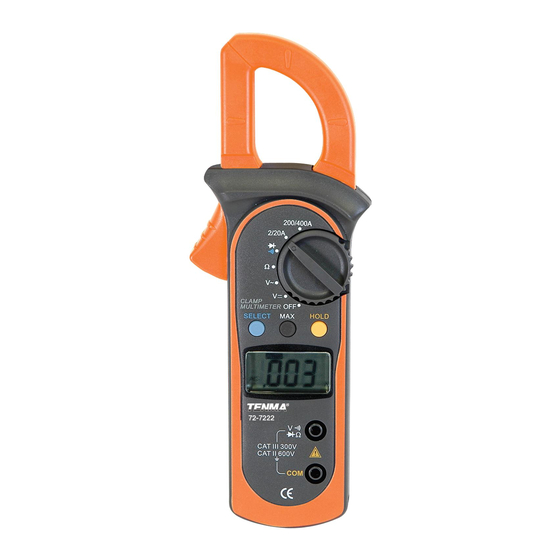Table of Contents
Advertisement
Advertisement
Table of Contents

Summary of Contents for Tenma 72-7222
- Page 1 Digital Clamp Meter Model: 72-7222...
-
Page 2: Safety Information
SAFETY INFORMATION Please read these instructions carefully before use and retain for future reference. This meter is designed to meet IEC61010-1, 61010-2-032, and 61010-2-033 in Pollution Degree 2, Measurement Category (CAT II 600V, CAT III 300V) and double Insulation. • Do not operate the meter or use test leads if they appear damaged, or if the meter is not operating properly. -
Page 3: Symbol Guide
SYMBOL GUIDE AC (Alternating Current) DC (Direct Current) AC or DC Grounding Double insulated Warning Low battery Continuity buzzer Diode Fuse Capacitance test Conforms to European Union directives FUNCTIONS Input terminals LCD Display Function buttons x 3 Range selector Trigger: press and release the trigger to open and close the detector jaw. -
Page 4: Operating Parameters
OPERATING PARAMETERS • Operating temperature: 23°C± 5°C • Relative Humidity: ≤75%. • Temperature Coefficient: 0.1× (specified accuracy)/1°C DC VOLTAGE AUTO RANGING Range Resolution Accuracy Overload Protection 200.0mV 0.1mV ±(0.8%+3) 2.000V 20.00V 10mV ±(0.8%+1) 600V rms 200.0V 100mV 600V ±(1%+3) Note: The input impedance is 10MΩ. AC VOLTAGE AUTO RANGING Range Resolution... - Page 5 DIODE AND CONTINUITY Range Resolution Accuracy Overload Protection Displays approximate forward voltage drop 600Vp 0.5V~0.8V Note: The open circuit voltage is about 1.48V. Range Resolution Accuracy Overload Protection When ≤50Ω, the 100mΩ 600Vp buzzer beeps. Notes: • The open circuit voltage is about 0.45V. •...
- Page 6 OPERATION Measuring DC Voltage Warning • To avoid damage to the meter, or risk of personal injury, do not attempt to measure higher than 600V. • The DC voltage ranges are 200.0mV, 2.000V, 20.00V, 200.0V and 600V. • To measure DC voltage, perform the following steps: Insert the red test lead into the Hz Duty% terminal and the black test lead into the COM terminal.
- Page 7 Measuring Resistance Warning • To avoid damage to the meter or to the devices under test, disconnect circuit power and discharge all the high-voltage capacitors before measuring resistance. The resistance ranges are 200.0Ω , 2.000kΩ , 20.00kΩ ,200kΩ ,2.000MΩ and 20.00MΩ. •...
- Page 8 Notes: • In a circuit, a good diode should still produce a forward voltage drop reading of 0.5V to 0.8; however, the reverse voltage drop reading can vary depending on the resistance of other pathways between the probe tips. • The LCD will display OL indicating either open circuit or wrong polarity connection.
- Page 9 • The LCD displays OL indicating the circuit being tested is open. • When continuity testing has been completed, disconnect the test leads from the circuit under test, and remove them from the input terminals. Measuring AC Current Warning • To avoid electric shock, never measure current while the test leads are inserted into the input terminals.
-
Page 10: Specifications
Specifications A. General Specifications: Maximum voltage including transient 500V rms. overvoltage between any terminals and ground: Auto Polarity Display: 3 1/2 digits LCD display, Maximum display 1999 Overload : Display OL or –OL Low battery : Display Measurement Speed : Updates 3 times/second. -
Page 11: Maintenance
MAINTENANCE Cleaning • Clean the meter with a clean, soft cloth. • Do not use any chemicals, abrasives or solvents that could damage the meter. • Clean the terminals with a mild detergent, as dirt on the terminals can affect readings. - Page 12 INFORMATION ON WASTE DISPOSAL FOR CONSUMERS OF ELECTRICAL & ELECTRONIC EQUIPMENT These symbols indicate that separate collection of Waste Electrical and Electronic Equipment (WEEE) or waste batteries is required. Do not dispose of these items with general household waste. Separate for the treatment, recovery and recycling of the materials used. Waste batteries can be returned to any waste battery recycling point which are provided by most battery retailers.

















Need help?
Do you have a question about the 72-7222 and is the answer not in the manual?
Questions and answers